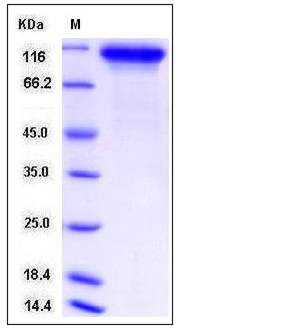Mouse Neuroligin 1 / NLGN1 Protein (His Tag)
6330415N05Rik,BB179718,mKIAA1070,NL1,Nlg1
- 100ug (NPP3429) Please inquiry
| Catalog Number | P50725-M08H |
|---|---|
| Organism Species | Mouse |
| Host | Human Cells |
| Synonyms | 6330415N05Rik,BB179718,mKIAA1070,NL1,Nlg1 |
| Molecular Weight | The recombinant mouse NLGN1 consists of 671 amino acids and predicts a molecular mass of 73.5 KDa. In SDS-PAGE under reducing conditions, the apparent molecular mass of rmNLGN1 is approximately 100-110 KDa as a result of glycosylation. |
| predicted N | Gln 46 |
| SDS-PAGE |  |
| Purity | > 97 % as determined by SDS-PAGE |
| Protein Construction | A DNA sequence encoding the mouse NLGN1 isoform 1 (Q99K10-1) extracellular domain (Met 1-Ser 697) was expressed, with a C-terminal polyhistidine tag. |
| Bio-activity | |
| Research Area | Neuroscience |Cell Adhesion Proteins |Membrane Proteins |
| Formulation | Lyophilized from sterile PBS, pH 7.4 1. Normally 5 % - 8 % trehalose and mannitol are added as protectants before lyophilization. Specific concentrations are included in the hardcopy of COA. |
| Background | Neuroligin 1 (NLGN1) belongs to the type-B carboxylesterase/lipase family, is a synaptic cell-adhesion molecule that is enriched in postsynaptic densities where it may recruit receptors, channels, and signal-transduction molecules to synaptic sites of cell adhesion. Neuroligins consist of five members (NLGN1, NLGN2, NLGN3, NLGN4 and NLGN4Y), which interact with beta-neurexins and this interaction is involved in the formation of functional synapses. The extracellular domain of functional Neuroligin 1 associates as a dimer when analyzed by sedimentation equilibrium. Neuroligin 1 has a unique N-linked glycosylation pattern in the neuroligin family, and glycosylation and its processing modify neuroligin activity. Neuroligin 1 is a potent trigger for the de novo formation of synaptic connections, and it has recently been suggested that it is required for the maturation of functionally competent excitatory synapses. The persistent expression of Neuroligin 1 is required for the maintenance of NMDAR-mediated synaptic transmission, which enables normal development of synaptic plasticity and long-term memory in the amygdala of adult animals. |
| Reference |
